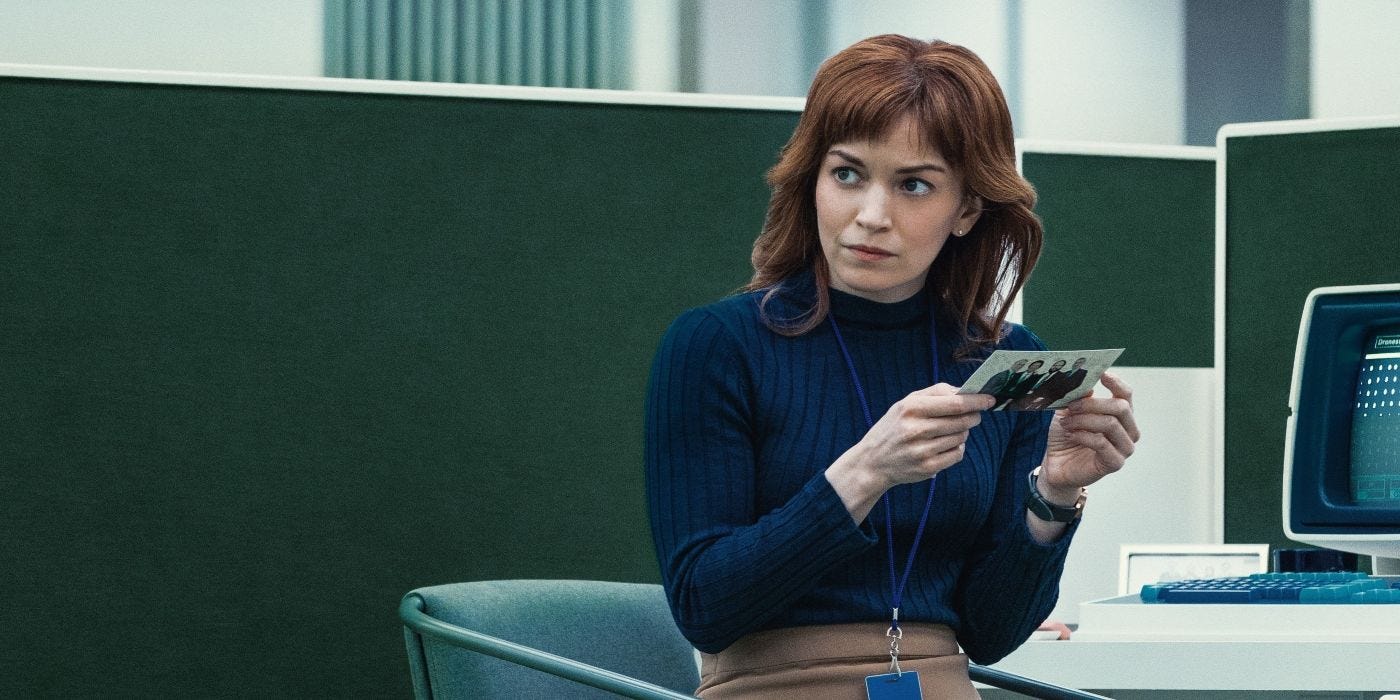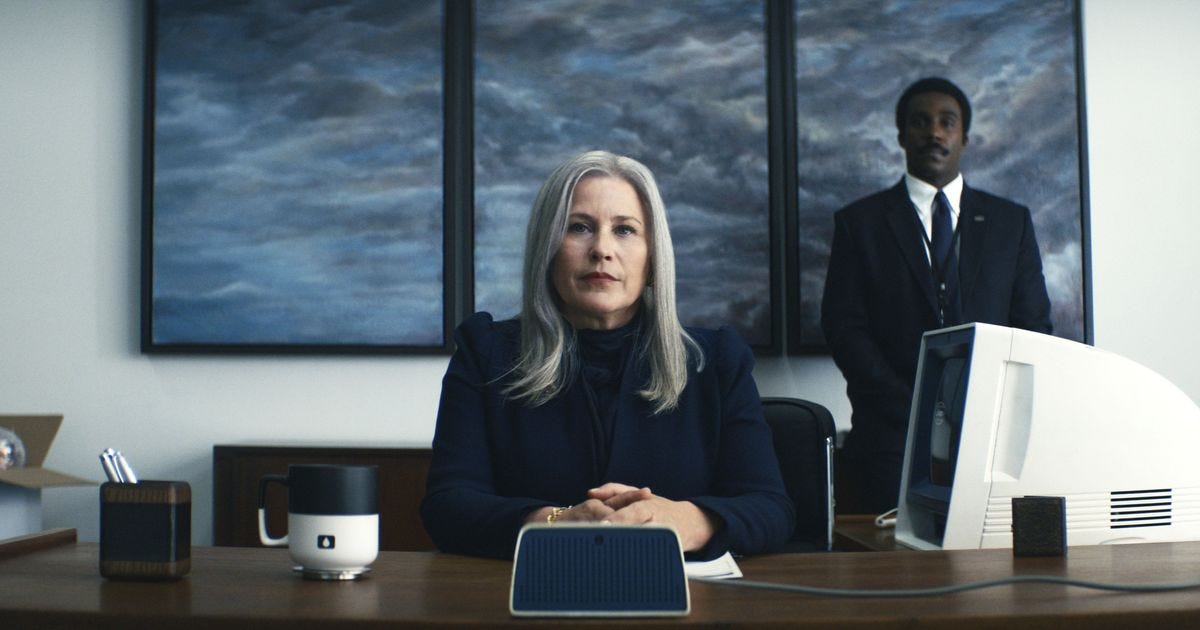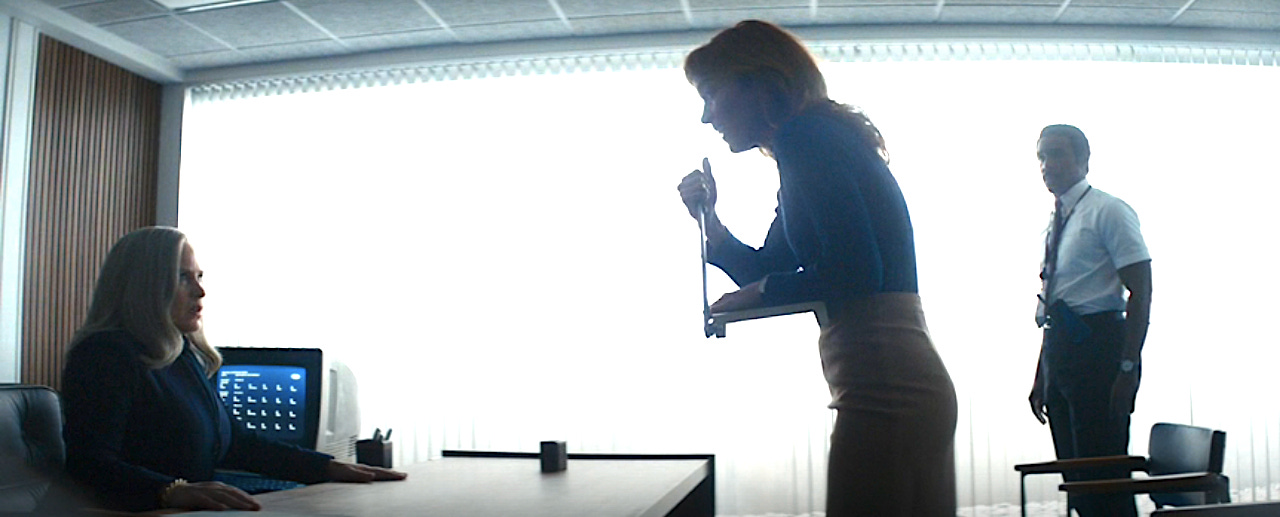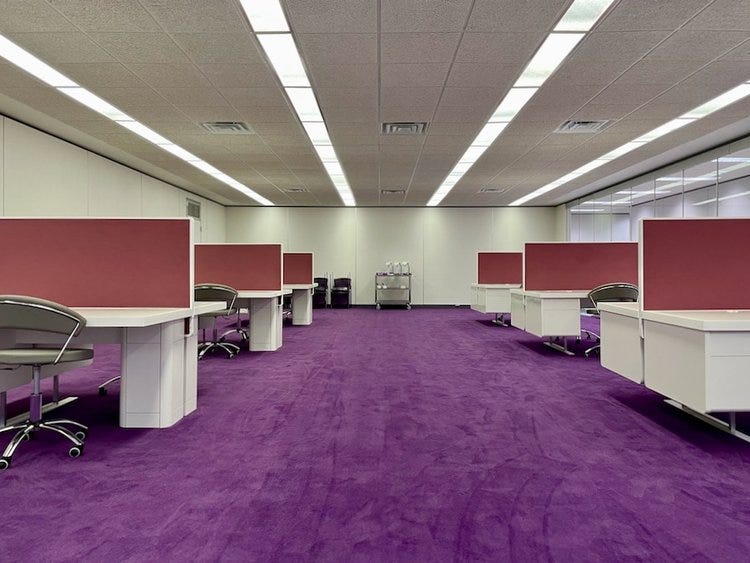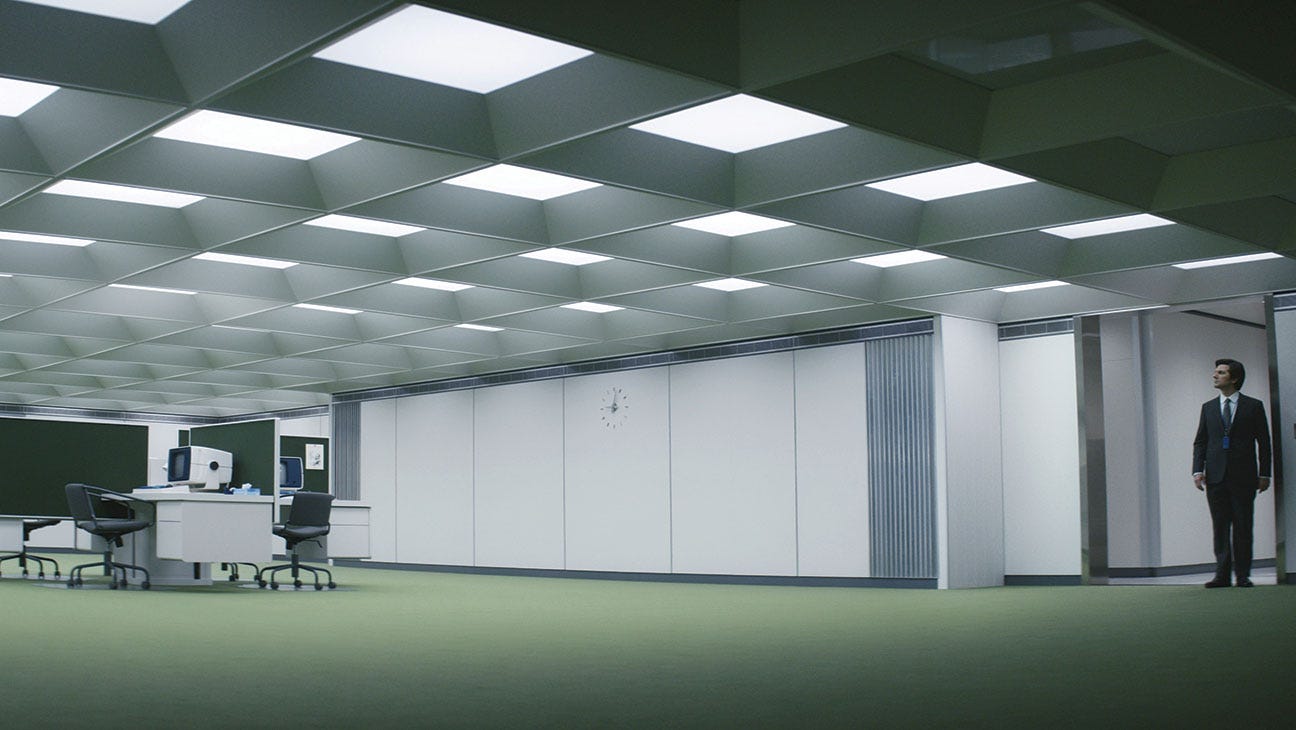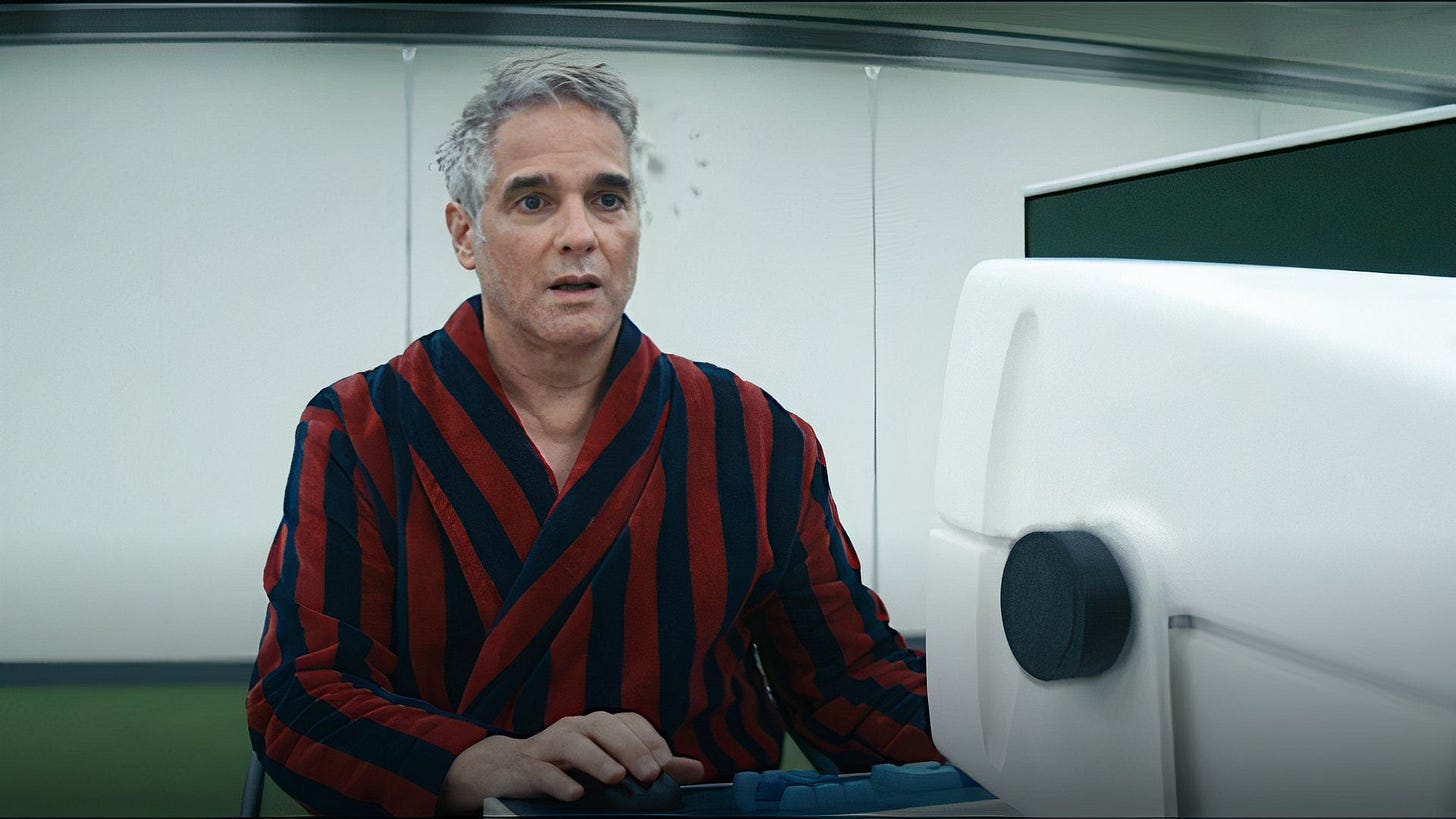the colors of Severance
"Lumon Blue" is a frontrunner for Pantone's Color of The Year
I started out watching Severance just this weekend with the Apple TV+ trial. It took me precisely all of Saturday afternoon to Sunday morning to catch up to the beginning of Season 2, where [Major Spoilers Ahead] the severed, Macrodata Refinement Department have returned to the Lumon offices after reaching the outside world through the overtime contingency—a function that allows the Innies, who only exist within the confines of Lumon, to experience the lives of their Outies, who exist outside of Lumon as people free to enjoy personal lives without any knowledge or recollection of their work inside Lumon’s severed floors.
Severance is the procedure that makes such a dual life possible, but as we see in Season 1 with the introduction of Helly R., a replacement for retired refiner, Petey, life inside Lumon as an Innie is a perpetual hell: you exist and operate only within the basement floor of Lumon, your only purpose and available activity being the refinement of “macrodata” whose contents are unknown but give off feelings of dread and anxiety, your days never truly ending or beginning as sleep, rest, family, friends, and the outside, are experienced only by your Outie.
Helly’s onboarding, as a result, is marked heavily by her attempts to escape Lumon, only to continually end back in the office as her Outie forces her to re-enter, eventually leading the other three refiners in the department, Mark, Dylan and Irving, to slowly unravel the mysteries of Lumon and discover their lives outside of it.
I binged the hell out the first season. And I’m kind of glad I didn’t hop on the Severance train while it was airing weekly in 2022, otherwise I wouldn’t have been able to see the whole picture the series was trying to paint; Binging meant I had all the clues squished together without all the splices of time in between. And its cast is phenomenal, with the writing and directing unbelievably good at convincing us of this surrealist world of the work/life balance at its most literal. But one of the biggest advantages of binging Severance (albeit three years after its initial release) is being able to absorb the color schema of the primary colored-world hidden inside the elusive Lumon offices.
When we first meet Helly, she’s sprawled out on the table post-op the severance procedure. She’s relatively new to this world, and herself, and as Mark attempts to guide her through orientation, one of the first scenes and look we have of Lumon’s offices is this conference room with a large, wood conference table, green leather chairs and this peculiar area rug that sets up the world of Lumon with two introductory colors: green and yellow. At the center of the rug, a green block extends out to border the edge of the conference table, where a border of yellow also begins.
This green reminded A LOT of the opening scene of The Good Place. When Eleanor first arrives in The Good Place, she’s immediately greeted by a white wall with the words, Welcome! Everything is fine! printed in giant, bold, green letters. Green is supposed to be relatively calming (think pastures, greenery, nature) and for Helly’s Innie, her arrival is much like birth, where everything is unknown and she’s suddenly found herself in this mysterious place without any prior recollections of anything outside of Lumon. The green here is supposed to be calming, the color of welcoming.
As Helly’s orientation continues, the Lumon offices reveal more brushes of green, like the Macrodata Refinement’s Department having a turf-like flooring beneath their desks, the floorplan very open, like a pasture or a field, and green paneling dividing the "open” cubicles of the Refinement team. Green is Lumon’s introductory color for easing their severed employees. When work environments double as their quarters of existence, it makes sense that Lumon would incorporate the same kinds of corporate attempts to up the livelihood of their offices, sprinkling green in the carpeting of the receiving area in front of the elevator entrance, placing green chairs in the reception area of their internal version of HR, the Wellness department.
But green is just the receiving color at Lumon. Pretty quickly, the color blue bleeds into every scene as we encounter the departmental staff overseeing the severed employees. Enter the antagonists of the series: the Lumon higher-ups.
In season 1, Ms. Cobel is everywhere. She’s the person the department heads, like Mark, report to, and the boss of deputy manager and disciplinarian, Mr. Milchick. When Mark is promoted to department head after Petey’s abrupt retirement, we see Ms. Cobel in her office, pocked with shades of blue, like the trio of sky paintings behind her desk, and her work attire ranging from shades of navy blue to ultramarine. When the Macrodata department visits the Perpetuity Wing where the history of Lumon is showcased in a sort of history museum layout, the inside of founder, Kier Egan’s home, is shrouded with linen and bedding of blue.
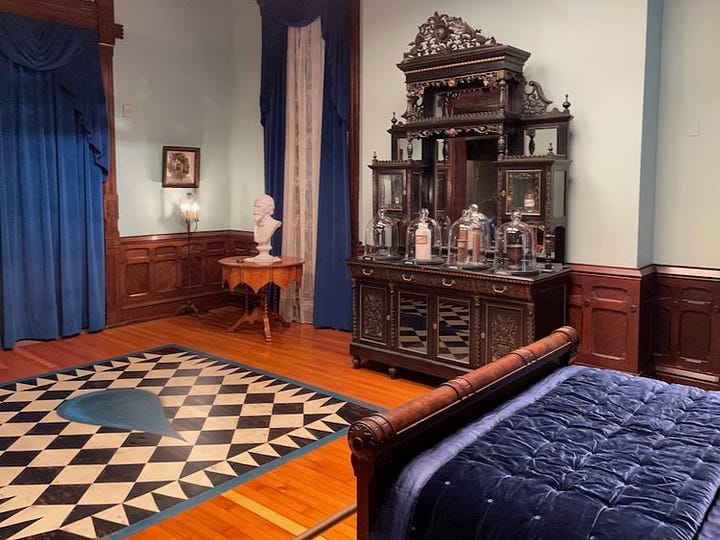
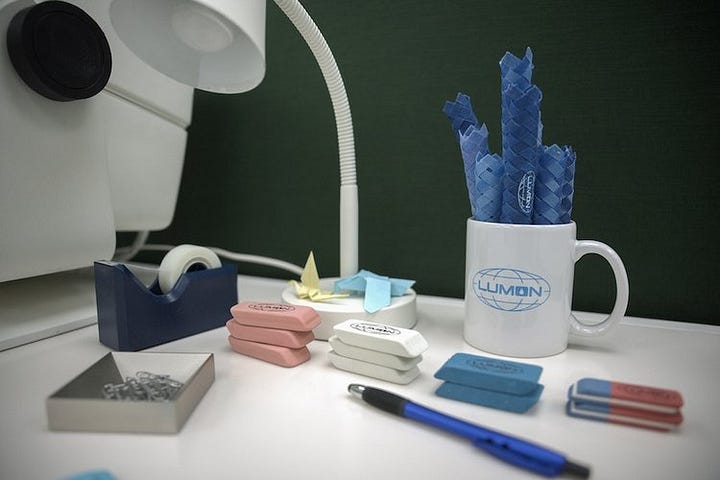
Blue has historical roots that run deep in the world of art and culture, but it unprecedently became a marker of class and wealth. 6th and 7th century paintings saw the use of ultramarine pigments produced from Lapis Lazuli, a semi-precious stone mined in regions of Afghanistan. It’s use during the Renaissance was commonly associated with holiness and humility in paintings of the Virgin Mary.1 Historically, it was one of the most expensive pigments to produce. It’s inclusion in the world of Severance, too, further drives the religious connotations referenced throughout Lumon’s severed (the Compliant Handbook as a biblical “word of Eagan” and the Core Principles as the Lumon version of the 10 Commandments), and it fuels a lot of Lumon’s corporate presence as symbol of wealth—profits over severed people.
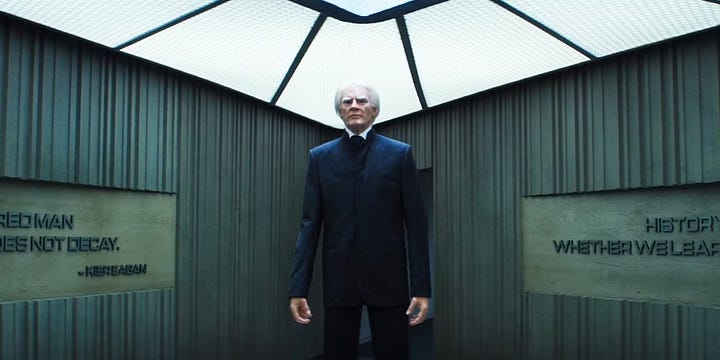

Lumon Blue is everywhere in Severance’s world. It’s the color of the emplyee’s badges, the keyboards and screens of Lumon’s equipment, the company-distributed fingertraps on Dylan’s desk, the primary shade of the employees’ work attire, in the luminescence of the fluorescent office lighting and in the wardrobe of Irving, one of Lumon’s most dedicated and loyal employees in the MDR department.
Lumon Blue is as inescapable as much as Lumon, itself, as we come to learn pretty quickly watching Helly’s attempts to resign from the office. But as Lumon’s and the severance procedure’s #1 hater, Helly comes second in the contest for Who Wears The Most Lumon Blue, and its heavenly foreshadowed from the beginning of Season 1 that Helly’s Outie gravitates toward a cerulean wardrobe for a major reason.
More MAJOR Spoilers Ahead:
In the Season 1 finale, when the Innies awaken in their Outies through the overtime contingency, we learn that Helly’s Outie is actually Helena Eagan, the daughter of Jame Eagan, who is Lumon’s eighth and current CEO. In a twist reveal, Helena’s involvement in the severed floor is a direct marketing campaign to globalize the severance procedure; Helly’s awakening in her Outie corresponds at a time when she’s scheduled to speak at the Eagan’s family gala about the positive effects of severance, and there, she abruptly reveals to the Lumon shareholders that the Innies experience terrible working conditions as severed employees. It’s a bombshell dropped right as the season comes to a close, and audiences are left to reconcile that the rebellious and resistant Helly is actually the face of severance.
But again, my binge-watch of Severance played a huge role in my interpretation of the show overall, so Helly’s association with Lumon overall becomes a not-so-subtle foreshadow when it came to observing her outfits all throughout Season 1.
Actually, if you re-watch episodes 1 through 8, you’ll kind of notice Helly’s choice of colors corresponds with her standing with Lumon, like her all blue-ensemble on her third day, where her first attempt at refining macrodata shows her slight acclimation to life as an Innie. Or, as we see in episode 4, when Helly is sporting a blue, long sleeved top and yellow pencil skirt, she grows increasingly resistant toward the office, threatening to cut off her fingers with a paper cutter unless upper management provides her with a video recorder to record a message for her Outie.
Yellow is sprinkled throughout the series in a way that signifies a presence of rebellion. For almost all of Helly’s appearances, we see her with subtle pops of yellow among the Lumon Blue attire. Even in her most monochromatic number, her butter yellow heels signal the undercurrent of unwillingness she has toward her life as an Innie.
In fact, much of the warmer tone colors that appear throughout the series signal the growing restless of the severed world and often allude to the outside, like Dylan’s yellow shirt foreshadowing his Innie being the first to resurface outside Lumon in episode 6, and Petey’s red and blue robe that he borrows from Mark’s Outie representing Petey’s reintegration into the outside world. Even the yellow outline in the green carpentry implies a false sense of autonomy and hope as the mellow green color outlining it traps it between green hues.
Other colors that appear throughout the show are the mysterious purple carpeted office that is hinted at several times in Season 1 (another departmentyet to be unveiled) and the hyper-red Code Detection lights that saturate the office as Helly repeatedly tries to sneak out messages to her Outie.
For the most part, however, Severance relies on the primary color block to fill in the world of Lumon, and it reminds me a lot of how primary schools introduce red, blue, green and yellow to describe the immediate world. The severed, in a way, are like children. Their Innies are “born” inside Lumon and “raised” by the ethics of the founder’s, their concealment from the world creating the perfect abode for integrating them into their office roles. And because secondary colors are typically more nuanced in meaning and context, the use of primary hues are rich in evoking emotional response and signaling direction, making it easier for the upper management to correct, null or evoke appropriate behaviors from their employees.
And though this next bit isn’t directly tied to color, I think its important to note that in our glimpses of the outside, the snowy, New-England-esque setting the Outies exist in still feels relatively warm compared to the inside of Lumon. As the severed employees repeatedly remark, they’ve never seen the outside sky. And by default, have never experienced a sunset or nightfall, the feeling of the sun. Warmth, in any form, is deprived within the Lumon building and the artificial lighting provided gives off this very antiseptic and relatively cold feeling. A cool tone color like blue was crucial to in showcasing just how deprived of warmth and visual nourishment these characters are receiving as dedicated (by no choice of their own) employees.
Fluorescent lighting and open floor work offices have been prone to a lot of flack in current reality, and it’s for good reason; Rachael Handler spoke to NYU’s associate professor of neurology, Dr. Minen, on the effects of fluorescent lighting2 and explained:
Dr. Minen told me that another way bad lighting ruins people’s lives is by depressing them and recommends that any patient who feels emotionally decimated by their office lighting get a SAD lamp and also get the hell outside in the middle of the day, for God’s sake!
The “open” offices the MDR department work in, too, gives the illusion of privacy and openness; they’re given high paneling in a four-corner square set-up to separate each employees’ desks from one another, but the approachability from behind suggests the workers are always subject to being observed. They quite literally have to watch their backs.
In fact, much of the unsettling aspects of Severance’s surrealist world is how much the surrealism reflects our modern work culture to the point of ordinary. On first glance, severance, as an idea, sounds like the solution-turned-horror of solving the work/life balance dilemma. But in reality, it describes the perfect corporate vehicle for compliance. The Outies don’t know what they do for a living, and therefore, aren’t able to question or investigate if their work contributes to any greater harm, prevents them from speaking up and convey autonomy. And more importantly, severance ushers in the creation of the ultimate workforce: employees bred to think about work, and only work, for the majority of their lives. Severance remarks on what happens when your work identity is your identity.
It’s a huge remark on an already capital-driven culture we live in where personal pleasures and hobbies are expected to double as side-hustles and corporate impositions on personal time and its demands for total commitment come up a lot in our daily lives. Even the way we talk about ourselves in conversation evokes a need to fluff up our current roles and our future aspirations, one of the first questions people tend to ask about you being, What Do You Do For A Living?
Work colors in all the open gaps of yourself, and the rising interest in Severance seems to ask, “How do you live if work is your entire life?”
Thanks for reading!
XOXO,
Val.
Rachael Handler’s Why Is Office Lighting So Bad? for Curbed.





